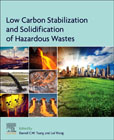
Low Carbon Stabilization and Solidification of Hazardous Wastes
Tsang, Daniel C.W.
Wang, Junlei
Low Carbon Stabilization and Solidification of Hazardous Wastes details sustainable and low-carbon treatments for addressing environmental pollution problems, critically reviewing low-carbon stabilization/solidification technologies. This book presents the latest state-of-the-art knowledge of low-carbon stabilization/solidification technologies to provide cost-effective sustainable solutions for real-life environmental problems related to hazardous wastes including contaminated sediments. As stabilization/solidification is one of the most widely used waste remediation methods for its versatility, fast implementation and final treatment of hazardous waste treatment, it is imperative that those working in this field follow the most recent developments. Low Carbon Stabilization and Solidification of Hazardous Wastes is a necessary read for academics, postgraduates, researchers and engineers in the field of environmental science and engineering, waste management, and soil science, who need to keep up to date with the most recent advances in low-carbon technologies. This audience will develop a better understanding of these low-carbon mechanisms and advanced characterization technologies, fostering the future development of low-carbon technologies and the actualization of green and sustainable remediation. Focuses on stabilization/solidification for environmental remediation, as one of the most widely used environmental remediation technologies in field-scale applications Details the most advanced and up-to-date low-carbon sustainable technologies necessary to guide future research and sustainable development Provides comprehensive coverage of low-carbon solutions for treating a variety of hazardous wastes as well as contaminated soil and sediment INDICE: Part I Overview of environmental remediation and stabilization/solidification 1. Sustainable waste management 2. Overview of low-carbon stabilization/solidification Part II Low-carbon stabilization/solidification (S/S) of contaminated soil and sediment 3. Green cementitious materials for S/S 4. Natural or organophilic clay for S/S 5. Nanomaterials for S/S 6. Biochar for S/S 7. S/S of contaminated river/lake sediment 8. S/S of contaminated marine sediment Part III Low-carbon stabilization/solidification of industrial waste 9. S/S of waste incineration fly ash and bottom ash 10. S/S of waste incineration bottom ash 11. S/S of industrial sludge (electroplating) 12. S/S of industrial sludge (mining) 13. S/S of sewage sludge ash 14. Remediation of mine waste 15. Remediation of tailing waste 16. Remediation of chemical waste 17. Utilization of waste slag 18. Utilization of coal fly ash and bottom ash 19. Utilization of contaminated bio-waste Part IV Low-carbon stabilization/solidification of radioactive waste 20. Cement-based S/S of radioactive waste 21. Glass-based S/S of radioactive waste 22. Ceramic-based S/S of radioactive waste 23. Chemical enhanced S/S of radioactive waste Part V Future prospects 24. Novel materials for S/S technologies 25. Advanced characterization for S/S technologies 26. New lab-scale analytical methods for S/S technologies 27. Life cycle analysis of S/S technologies 28. Cost-benefit analysis of S/S technologies 29. Sustainable waste management and circular economy 30. Future research directions for sustainable remediation
- ISBN: 978-0-12-824004-5
- Editorial: Elsevier
- Encuadernacion: Rústica
- Páginas: 590
- Fecha Publicación: 21/09/2021
- Nº Volúmenes: 1
- Idioma: Inglés
